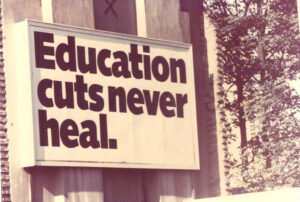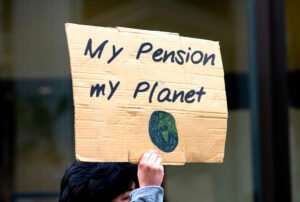
This article concludes a series of articles co-produced by Good Jobs First and NPQ, titled Checking Corporate Welfare, Stories from the Front Lines. In this series, we take a hard look at the current system, which enables corporations to write off $95 billion from their state and local tax bills each year—and how local groups are organizing in cities across the nation to challenge this system. In these articles, we have featured community leaders who, armed with data, are developing innovative public campaigns that are beginning to contain these corporate tax abatements—and restore funding for public schools and local public services.
When I was a journalist, one of the cities we covered faced significant budget cuts. At the top of the chopping block in the majority-Latinx community, in the poorest section of town, were a library and boxing gym. Advocates for keeping the facilities open included a former boxing champ who had trained at the gym and made a special out-of-town trip to beg public officials not to close it.
After countless hours of organizing and impassioned pleas to elected officials, both facilities stayed open, thanks in part to a $10,000 county grant that residents won for the city.
This was in the same place which, only a few years earlier, had spent not $10,000, but millions, to subsidize a new shopping center on prime Southern California land located a stone’s throw from the Ventura Freeway in Ventura County. The publicly subsidized project drained tax revenues from downtown and doomed a nearby once-thriving shopping center. But the new project did not generate new economic activity; rather, it simply changed the place where consumers made their purchases.
Yet here were residents spending long hours after work begging for a few thousand dollars to keep two vital resources open in the city’s most-under-resourced, neglected neighborhood.
I have seen this story time and again—huge budget expenditures get approved with little discussion, while community groups beg for scraps. This led me to an important lesson that took a while to appreciate—elected officials have choices. Budgets reflect those choices, and when it comes to making municipal policy decisions, some actors have had far too much power—especially chambers of commerce, developers, and deep-pocketed companies that fund politicians’ campaigns.
I think about this a lot as I consider the way economic development is done across the United States. The idea persists, despite all contrary research, that a big company, aided by millions or even billions in taxpayer dollars, can come in and raise the standard of living for all.
It isn’t true. It doesn’t work. Yet the mirage continues.
But increasingly, a growing group of community advocates are demanding more thoughtful economic development strategies—and they are winning. They are aided by research showing that to drive real economic gains, communities must invest in schools, parks, roads, infrastructure, senior services, childcare support, and other amenities that especially benefit those of modest means.
Companies go where skilled workers are, and workers gravitate toward communities that offer a high quality of life. In short, if elected officials prioritize building infrastructure and providing services that most benefit residents, employers will come.
But to change the way economic development is done, everyone must play a role. The process starts with getting informed, agitating for something better, and having proven alternatives. In this series, we have heard directly from advocates in Louisiana, Texas, and Missouri. These are just a few examples from a much broader movement that is taking hold in cities and counties across the nation.
Another Example: The Case of South Carolina
South Carolina offers a good example of how an economic development strategy that is overly dependent on tax breaks fails the greater good. The state ranks near the bottom of the nation when it comes to the quality of public education, and opportunities remain starkly divided by race. African Americans, who comprise 27 percent of the population, represent 60 percent of the low-income population, and schools with high Black student populations are less likely to have money for basic needs.
South Carolina public schools, in fact, have the dubious distinction of losing the most reported money of any state in the country to corporate tax breaks. The state’s Commerce Department boasts the many ways a company can boost profits while keeping its tax bills low: Eliminate your entire corporate income tax bill! Avoid local property taxes! No sales tax charged on your largest purchases!
The list goes on.
On the other end of those corporate giveaways are the public agencies that never see the revenue they would have had if companies paid their fair share of taxes. For South Carolina public schools, that loss totaled $534 million in fiscal year 2021; over five years it was $2.2 billion.
The practice infuriates South Carolina Education Association President Sherry East.
“How many things could this fix, and how many buildings could this repair, and how many teacher salaries and support staff could be hired with the money we are handing to profitable organizations?” she asked during a recent conversation about the problem.
No district in South Carolina loses more revenue to corporate tax breaks than the Berkeley County School District. The losses are big enough, the Post & Courier wrote last year, to cover the cost of building a new high school every year. Indeed, at a recent school board meeting, elected leaders discussed their plans to put a sales tax measure on the ballot to pay for new schools and renovate existing ones.
That’s what happens when one school district foregoes $84 million of revenue in a single year, as Post & Courier found in its analysis of public spending documents. The tax burden shifts regressively from large corporations to working families.
And get this: Berkeley school officials don’t even have a say in whether their money is given away. The county controls those decisions, solely.
Data Drives the Movement
It is, simply put, not right that local politicians debate small grants to nonprofits at length, while tax abatements to corporations at far greater cost are granted in secret. This is beginning to change, but the path to data disclosure has not been easy.
Sign up for our free newsletters
Subscribe to NPQ's newsletters to have our top stories delivered directly to your inbox.
By signing up, you agree to our privacy policy and terms of use, and to receive messages from NPQ and our partners.
The National Community Reinvestment Coalition (NCRC) often likes to say that “data drives the movement.” NCRC is referring to the role of the Home Mortgage Disclosure Act (HMDA) and the Community Reinvestment Act (CRA) in enabling communities to alter bank behavior, increasing lending and investment in previously redlined neighborhoods. The same theme holds for corporate tax abatements. It is hard for the public to exercise effective control over the billions given away to corporations to (allegedly) “incentivize” investment if neither the amount given nor the names of tax abatement recipients are publicly available.
It is, simply put, not right that local politicians debate small grants to nonprofits at length, while tax abatements to corporations at far greater cost are granted in secret. This is beginning to change, but the path to data disclosure has not been easy.
We know about the millions of dollars of revenue denied to South Carolina schools—and indeed to cities and counties throughout the nation—thanks to a statement recently issued by the (GASB), Statement No. 77 on Tax Abatement Disclosures—GASB 77 for short. It may sound technical or boring, but it’s actually quite straightforward—and exciting because it’s so powerful!
This landmark reform in municipal finance says that in their end-of-year spending report—called the Annual Comprehensive Financial Report—most local and state governments must disclose how much tax revenue they lost to economic development tax break programs. Such programs are the only type of tax expenditure GASB has ever codified, and this information has only been available to the public since fiscal year 2017.
How did this “HMDA” of the movement to rein in corporate tax abatements come to be?
Good Jobs First (the organization for which I work) organized to first put the issue on GASB’s agenda, and it urged academics, nonprofit organizations, unions, and policymakers to submit comments in support of GASB 77 when it came under formal consideration in 2014 and 2015. All told, 298 comments from several hundred organizations and individuals were submitted. They successfully argued that poorly disclosed tax abatements, which add up nationwide to at least $70 billion and as much as $95 billion per year—is a material factor in communities’ finances, and so people deserve to know how much of a tax break is given, to whom, and where.
Strengthening GASB 77
Even with GASB 77 in place, too many gaps remain. Especially where state officials are lax, compliance remains a challenge. For far too long, companies and politicians have touted the benefits of economic development. Have they focused on the costs? Not so much. It’s up to the public to ask probing questions. GASB 77 is a good place to start. But it needs more teeth.
We need to know which companies are getting tax breaks, how much they are getting, what communities have been promised in return, and whether companies deliver on their promises over time.In the months ahead, a group of organizations (including Good Jobs First) will continue urging GASB to strengthen Statement 77. For example, the standard doesn’t explicitly include revenue diverted through tax increment financing (TIF). It may also miss abatements bundled with industrial revenue bonds (a backdoor way by which many companies receive millions of dollars in property tax breaks each year).
Again, data transparency is critical. We need to know which companies are getting tax breaks, how much they are getting, what communities have been promised in return, and whether companies deliver on their promises over time. It is infuriating how difficult it can be to get such basic details, considering the matter involves public tax dollars. Tax revenue is our money. We should know where it is going.
In our work across the country, we’ve noticed how often people, including elected officials, are unaware of how extensive these giveaways are. Too many elected officials still accept at face value the claims companies make about what is essentially trickle-down economics.
In response, the challenge is two-fold: first, to get informed, and then to act.
Advocates Mobilize for Community Benefits
What does action look like? Lately, several community efforts have centered on Amazon. The bottom line: if corporations like Amazon want a public subsidy, they should expect to provide commensurate public benefits. For example, in 2021, word got out that the Port Authority of New York and New Jersey had tentatively reached an agreement to lease to Amazon for 20 years enough space at Newark Liberty International Airport for two 250,000-square-foot air cargo facilities.
The entire deal was shrouded in secrecy, but workers, environmental justice advocates, residents, and others mobilized quickly. They knocked on thousands of doors, spoke at countless meetings, and demanded Amazon mitigate its pollution and provide employees living wages and fair working conditions. Rather than meet those conditions, Amazon walked.
A similar story comes from San Diego, CA. There, Amazon pulled plans to build a warehouse because local officials insisted the company pay workers prevailing market wages and provide 56 hours of annual sick leave (remember: many Amazon workers, deemed “essential,” have had to work sick during the pandemic because they risk being fired for taking time off).
In San Francisco, a coalition of labor, environmental, and resident groups are demanding that Amazon agree to a community benefits agreement before it builds a 650,000-square-foot warehouse. This community benefit approach is particularly refreshing. Among the community demands: in exchange for tax abatement, coalition members are insisting that Amazon invest in local jobs and affordable housing and support public transit and other measures to reduce its carbon footprint.
As Good Jobs First has argued since 2016 when our group first documented Amazon’s subsidy-seeking binge, there is no reason any community should subsidize Amazon. In fact, Amazon should pay the municipalities in which its warehouses are located in exchange for the problems they bring. Data show that Amazon workers are more likely to be injured and are paid less than comparable warehouse workers. Data also shows that, when Amazon arrives in an area, local retailers lose sales, and commercial property values and tax revenues decline. The company is also, of course, massively profitable. The public should hardly be paying to further boost stockholder gains.
Amazon is hardly the only corporation with a long track record of receiving public subsidies and provoking community resistance. East of Atlanta, opponents of a $1.5 billion subsidy to Rivian, an electric vehicle start-up, sued this year to invalidate half of the abatement package. The coalition’s lawsuit contends that the $700 million offered in local property tax breaks runs afoul of a state constitution provision that bars public gifts. However, many states, including Georgia, routinely dodge such prohibitions with workarounds, such as building a facility with tax-free credit through a public authority then leasing the facility to a private company. With no property tax due on the technically public property, the company may pay a small “Payment in Lieu of Taxes,” or PILOT.
Coming Together for Something New
Reviewing one corporate subsidy deal after another, one could be forgiven for feeling cynical. Some days, I do. But far more often, I feel hopeful about the new direction economic development can take. I am energized by communities that are taking matters into their own hands and challenging powerful companies eager to extract, extract, extract—and these communities winning.
Community groups cannot afford to be solely reactive, of course. It is critical to set the tone for a deeper conversation about what economic justice and lasting community-centered economic development requires. In New York City, community groups—including those that in 2019 thwarted Amazon’s plans to build a massive subsidized Queens-based headquarters—have done a great job at showing how expanding early education, healthcare, housing, and support for excluded workers are all better ways of growing the state’s economy than megadeals.
So many interests meet at the intersection of economic, worker, racial, tax, environmental, and community justice. As groups increasingly come together at such corners, there is no limit to what can be done collectively to create an economy that finally works for all of us.
Elected officials make choices every day. Let’s help them make better choices: instead of big tax giveaways, let’s help them say yes to the public amenities and services that are the true drivers of healthy, thriving, equitable communities.











